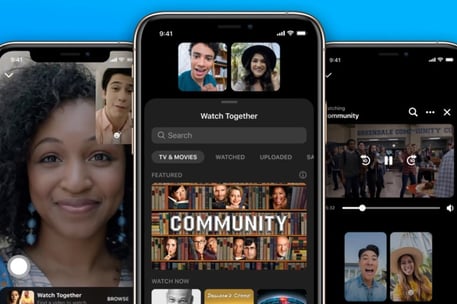2021 was a year of unimaginable growth in streaming. From the impact of COVID-19 and people working from home, to the rise of interactive video content, analysts estimate that consumer’s dependence on streaming services for their entertainment and communication saw over 200% growth in 2021. In-fact, live video is expected to grow 15-fold by 2022 and reach a 17% share of all internet traffic.
With the anticipated growth in streaming, what can we expect in terms of content, applications, protocol and/or licensing trends in the next year? Below are four predictions we anticipate seeing in 2022.
Watch more — Together
COVID has fundamentally changed the way that people interact. The simple fact is that more people are sitting at home because of either pandemic fears and lockdowns,  closed venues or lack of opportunities to get together outside of the home. But amidst the shrinking of physical social opportunities, we’ve rallied around the screen to find ways to play games, have virtual drinks with friends and watch our favorite content together. In many cases, the virtual lifeline has given us the opportunity to rekindle old friendships, and connect with family in a way that we hadn’t considered before.
closed venues or lack of opportunities to get together outside of the home. But amidst the shrinking of physical social opportunities, we’ve rallied around the screen to find ways to play games, have virtual drinks with friends and watch our favorite content together. In many cases, the virtual lifeline has given us the opportunity to rekindle old friendships, and connect with family in a way that we hadn’t considered before.
Because virtual gathers have become a common practice, we anticipate more growth in the watch together and play together segments for video applications. From activities like Yahoo! Fantasy Football and the NFL Virtual Couch, to services like PLEX and Teleparty; more applications will feature ways to enjoy live broadcasts while interacting with friends and family.
Betting Big on Sports Betting
It may be bold, but we anticipate that 35–40 states will legalize  sports betting and 20–25 states will have it available on mobile by the end of 2022. We’ve seen multiple states and gaming commissions begin exploring how to increase tax revenues and gaming opportunities to satisfy the at-home viewer and virtual OTBs. Moreover, with the growth of FanDuel, DraftKings, BetMGM and many other mobile platforms, the timing is right for states to recognize the potential revenue opportunities presented by the segment.
sports betting and 20–25 states will have it available on mobile by the end of 2022. We’ve seen multiple states and gaming commissions begin exploring how to increase tax revenues and gaming opportunities to satisfy the at-home viewer and virtual OTBs. Moreover, with the growth of FanDuel, DraftKings, BetMGM and many other mobile platforms, the timing is right for states to recognize the potential revenue opportunities presented by the segment.
Further, we anticipate that many of the applications that receive approval will begin incorporating microbetting and real-time streaming into their experiences. Microbetting provides an incremental revenue source based upon real-time game action by betting on every play— giving fans and viewers alike the chance to “feel” like they’re a part of the action when not physically at the game. In order to power these experiences, more apps will turn to WebRTC and sub-second delivery services to ensure that every fan gets both the same experience while ensuring that nobody has a “betting advantage” due video latency.
Greater Security, More Reliability
As CDNs and 5G mobile networks invest in edge computing continue to meet the rising video streaming demand, there’s also going to be an increase in adoption of Secure Reliable Transport (SRT) protocol. As an open-source protocol, SRT helps both with ingest and transport of low-latency streams across the public internet. Because more content creators and consumers require ultra-low latency streams that extend beyond the reaches of mobile network or CDN control, it makes sense to trust a delivery protocol to aid in both point-to-point communication, as well as cloud-based contribution and editing platforms.

Streaming to Rival Broadcast in Rights Fight
When it comes to live sports, the streaming demand is rivaling broadcast networks. More deals are being cut to allow major sports leagues and teams to have streaming-only content, as well as live airing of games rights shared between broadcasters, direct-to-consumer streaming services, and possibly in the future, sportsbook apps. 2022 may be the year that the rights to a tier-1 sporting event, league or playoff series will be sold exclusively on a DTC streaming service. Apple has already been in the works to negotiate exclusive content for its AppleTV streaming service, and Amazon Prime Video has been working with the NFL, MLB and other leagues to gain more live sports streaming. In addition, Hulu’s live sports and the recent growth in ESPN+ show that both companies (backed by Disney) could sustain viewership of live sports, while meeting the cost for exclusive licensing.
The year ahead is full of exciting opportunities in streaming media, and fortunately Phenix is available to assist with all of them. In 2021 we powered the largest concurrent streaming events, helped the newest sports and entertainment apps grow and scale to audiences around the world, and pushed the needle for real-time video applications.




